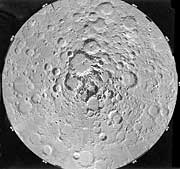The scientists have reduced the hopes of finding large amounts of water in dark regions on the moon

The North Pole of the Moon. Weak resonance in the radar test
The scientists have reduced the hopes of finding large amounts of water in dark regions on the moon. Last Wednesday 12/11/03 new evidence arrived according to which if such reservoirs exist, they are extremely small.
Data transmitted from the Clementine and Lunar Prospector spacecraft that circled the moon in the XNUMXs suggested the possibility of large amounts of water, essential to supporting a human colony on the moon, being in hidden craters near the lunar poles. However, after a crater survey conducted using radar and which focused on locating permanently shadowed craters near the poles, Bruce Campbell and his colleagues from the Smithsonian Institution in Washington say that they have so far not uncovered any evidence of thick ice deposits.
Any presence of lunar ice in the areas visible to Arecibo's radar must be in the form of isolated nuclei or a thin layer." Campbell said in a report in the scientific journal Nature.
The radar waves from the Haredi telescope in Arecibo, Puerto Rico can examine the craters in depth. However, he was unable to find strong echoes that could indicate large blocks of ice.
Weak echoes mean that if ice deposits are present, they are incorporated into the rocks. If there is water, it came from comets, which include a large amount of ice crashed on the moon over billions of years. The scientists believe that most of this water evaporated into space, but it is possible that some of this water was collected in shadowy craters near the lunar poles.
The presence of water on the moon is important because this water could be used as rocket fuel and a water supply station for manned voyages in the solar system. Campbell and his team believe that the findings show that either the number of comets that crashed and therefore the amount of water that reached the moon is lower than that which reached other bodies in the solar system, or that the water evaporated quickly.
Ice on the moon? Maybe a little, in grains
Water is to the moon what oil is to the earth. The very possibility that they exist in large quantities is enough to arouse the enthusiasm of certain people - astronomers or those who dream of human life on the stars, who see these waters as a source of nutrition and even energy for the use of future explorers of worlds.
Scientists from the Smithsonian Institution, Cornell University, and the Arecibo Observatory in Puerto Rico recently shut down the joy. The researchers reported in the journal "Nature" that according to radar images there is indeed water at the poles of the moon, but in a relatively small amount.
The hypothesis that there is water on the moon was first presented in the mid-90s when, from information received from satellites, it was possible to conclude that there are large amounts of ice in the craters at the poles. The hypothesis put forward at the time was that the water - in billions of tons - originated from comets that collided with the moon during its billions of years of existence.
Elsewhere on the surface of the moon the water would have evaporated long ago, but in the polar craters there are areas that are permanently shadowed, and the temperatures there are far below freezing. Thus, large reservoirs of ice may be found below the surface. Among other things, the researchers dreamed of producing fuel from water by breaking it down into hydrogen and oxygen (hence the interest the interstellar dreamers discovered in them).
But the radar test did not measure a strong resonance indicating the presence of ice reservoirs (such a resonance was measured in similar studies on the polar craters on the planet Hema). The researchers hypothesize that if there is ice at the poles, it is assumed that it is there in the form of grains spread over a large area or that it is thin layers of ice. This may be enough for the research of scientists, but the dreamers will have to look elsewhere.
New York Times
Living on the moon?
Alex Doron
The old dream of humanity - to establish a permanent hold on the moon - is fading away. The reason: it turns out that there is not enough usable water on the moon for a prolonged stay of humans.
5 years ago, NASA estimated that the amount of ice at the lunar poles ranges from 11 million to 328 million tons, and it is spread over about 40 thousand square kilometers. This amount was supposed to be enough for drinking, bathing, producing oxygen for the inhabitants of the lunar base, and also for producing rocket fuel for a space vehicle that would return them to Earth.
But scientists from the Center for Planetary Studies at the Smithsonian Institution in Washington, D.C., who reexamined the data, determined that the amount of ice on the moon is much lower than even the first, most minimalist estimate. The study, the details of which were published in the journal Nature, relied on old NASA data and recent observations at the Arecibo telescope in Puerto Rico.
The scientists also compared signal returns sent to the ice craters on the moon with return signals sent to the ice-rich planet Venus. The discrepancies in this experiment confirmed their conclusion.
"The new findings make the idea of permanent human settlement on the moon much more difficult to realize," said Dr. David Rothery from the Department of Earth Sciences at the Open University in the UK. In contrast, other scientists believe that an ice-melting facility could be placed on the moon - but it would be able to satisfy the needs of a few people and allow only a short stay.
